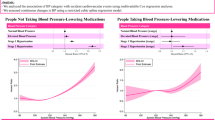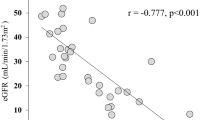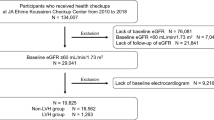Abstract
In the Losartan Intervention For Endpoint reduction (LIFE) study left ventricular (LV) hypertrophy was associated with increased urine albumin/creatinine ratio (UACR) at baseline. To evaluate whether this association was due only to parallel blood pressure (BP)-induced changes we re-examined the patients after 1 year of antihypertensive treatment to investigate whether changes in LV hypertrophy and UACR were related independently of changes in BP. In 7142 hypertensive patients included in the LIFE study, we measured UACR, LV hypertrophy by electrocardiography, plasma glucose and BP after 2 weeks of placebo treatment and again after 1 year of antihypertensive treatment with either an atenolol or a losartan based regime. At baseline and still after 1 year of treatment logUACR (R = 0.28, P < 0.001) was still correlated to LV hypertrophy (β = 0.05) assessed by ECG independently of systolic BP (β = 0.16), plasma glucose (β = 0.19) and age (β = 0.08). Change in logUACR (R = 0.19, P < 0.001) during treatment was correlated to change in LV hypertrophy (β = 0.10) independently of reduction in systolic BP (β = 0.13) and change in plasma glucose (β = 0.06). After 1 year of antihypertensive treatment UACR was still related to LV hypertrophy independently of systolic BP, and the reduction in UACR during that first year of treatment was related to regression of LV hypertrophy independently of reduction in systolic BP. This suggests that the relationship between LV hypertrophy and glomerular albumin leakage is not just due to parallel BP-induced changes. As glomerular albumin leakage may represent generalised vascular damage we hypothesise a vascular relationship between cardiac and glomerular damage.
This is a preview of subscription content, access via your institution
Access options
Subscribe to this journal
Receive 12 digital issues and online access to articles
$119.00 per year
only $9.92 per issue
Buy this article
- Purchase on Springer Link
- Instant access to full article PDF
Prices may be subject to local taxes which are calculated during checkout
Similar content being viewed by others
References
Parving HH . Microalbuminuria in essential hypertension and diabetes mellitus J Hypertens Suppl 1996; 14: S89–S93
Pedrinelli R . Microalbuminuria in hypertension Nephron 1996; 73: 499–505
Levy D et al. Prognostic implications of echocardiographically determined left ventricular mass in the Framingham Heart Study N Engl J Med 1990; 322: 1561–1566
Borch-Johnsen K et al. Urinary albumin excretion. An independent predictor of ischemic heart disease Arterioscler Thromb Vasc Biol 1999; 19: 1992–1997
Agrawal B, Wolf K, Berger A, Luft FC . Effect of antihypertensive treatment on qualitative estimates of microalbuminuria J Hum Hypertens 1996; 10: 551–555
Pedrinelli R et al. Microalbuminuria and transcapillary albumin leakage in essential hypertension Hypertension 1999; 34: 491–495
Jensen JS, Borch-Johnsen K, Jensen G, Feldt-Rasmussen B . Microalbuminuria reflects a generalized transvascular albumin leakiness in clinically healthy subjects Clin Sci Colch 1995; 88: 629–633
Rosa TT, Palatini P . Clinical value of microalbuminuria in hypertension J Hypertens 2000; 18: 645–654
Redon J et al. Hyperinsulinemia as a determinant of microalbuminuria in essential hypertension J Hypertens 1997; 15: 79–86
Mimran A, Ribstein J, DuCailar G, Halimi JM . Albuminuria in normals and essential hypertension J Diabetes Complications 1994; 8: 150–156
Hoogeveen EK et al. Serum homocysteine level and protein intake are related to risk of microalbuminuria: the Hoorn Study Kidney Int 1998; 54: 203–209
Summerson JH, Bell RA, Konen JC . Racial differences in the prevalence of microalbuminuria in hypertension Am J Kidney Dis 1995; 26: 577–579
Kuusisto J, Mykkanen L, Pyorala K, Laakso M . Hyperinsulinemic microalbuminuria. A new risk indicator for coronary heart disease Circulation 1995; 91: 831–837
Bigazzi R, Bianchi S, Baldari D, Campese VM . Microalbuminuria predicts cardiovascular events and renal insufficiency inpatients with essential hypertension J Hypertens 1998; 16: 1325–1333
Wachtell K et al. Microalbuminuria in hypertensivepatients electrocardiographic left ventricular hypertrophy. The LIFE Study J Hypertens 2002; 20: 405–412
Dahlof B . et al. Characteristics of 9194patients with left ventricular hypertrophy: the LIFE study Hypertension 1998; 32: 989–997
Okin PM et al. Relation of echocardiographic leftventricular mass and hypertrophy to persistent electrocardiographic left ventricular hypertrophy in hypertensivepatients: the LIFE Study Am J Hypertens 2001; 14: 775–782
Rowe DJ, Dawnay A, Watts GF . Microalbuminuria in diabetes mellitus: review and recommendations for the measurement of albumin in urine Ann Clin Biochem 1990; 27: 297–312
Irgens-Moller L, Hemmingsen L, Holm J . Diagnostic value of microalbuminuria in pre-eclampsia Clin Chim Acta 1986; 157: 295–298
Jensen JS, Borch-Johnsen K, Feldt-Rasmussen BF, Jensen G . Screening of microalbuminuria with the Micral-Test. A semi- quantitative urinary dipstick Ugeskr Laeger 1993; 155: 4155–4157
Borch-Johnsen K, Wenzel H, Viberti GC, Mogensen CE . Is screening and intervention for microalbuminuria worthwhile inpatients with insulin dependent diabetes? BMJ 1993; 306: 1722–1725
Feldt-Rasmussen B et al. Microalbuminuria: an important diagnostic tool J Diabetes Complications 1994; 8: 137–145
Redon J et al. Microalbuminuria, left ventricular mass and ambulatory blood pressure in essential hypertension Kidney Int Suppl 1996; 55: S81–S84
Pedrinelli R et al. Microalbuminuria and pulse pressure in hypertensive and atherosclerotic men Hypertension 2000; 35: 48–54
Jensen JS et al. Urinary albumin excretion and history of acute myocardial infarction in a cross-sectional population study of 2,613 individuals J Cardiovasc Risk 1997; 4: 121–125
Pontremoli R et al. Microalbuminuria is an early marker of target organ damage in essential hypertension Am J Hypertens 1998; 11: 430–438
Pontremoli R et al. Microalbuminuria: a marker of cardiovascular risk and organ damage in essential hypertension Kidney Int Suppl 1997; 63: S163–S165
Mykkanen L et al. Microalbuminuria and carotid artery intima-media thickness in nondiabetic and NIDDM subjects. The Insulin Resistance Atherosclerosis Study (IRAS) Stroke 1997; 28: 1710–1716
Bigazzi R et al. Increased thickness of the carotid artery inpatients with essential hypertension and microalbuminuria J Hum Hypertens 1995; 9: 827–833
Olsen MH et al. Parallel cardiovascular and renal glomerular abnormalities in longstanding hypertension. A LIFE substudy J Hypertens 2000; 18 (Suppl 4): S36
Jones EC et al. Relation of hemodynamic volume load to arterial and cardiac size J Am Coll Cardiol 1997; 29: 1303–1310
Olsen MH et al. Influence of blood pressure versus circulating growth factors on cardiovascular remodeling in hypertension. A LIFE-Substudy Circulation 1999; 100: I–604
Pontremoli R et al. The deletion polymorphism of the angiotensin I-converting enzyme gene is associated with target organ damage in essential hypertension J Am Soc Nephrol 1996; 7: 2550–2558
Redon J et al. Factors related to the presence of microalbuminuria in essential hypertension Am J Hypertens 1994; 7: 801–807
Pontremoli R et al. Prevalence and clinical correlates of microalbuminuria in essential hypertension: the MAGIC Study. Microalbuminuria: A Genoa Investigation on Complications Hypertension 1997; 30: 1135–1143
Kario K et al. Activation of tissue factor-induced coagulation and endothelial cell dysfunction in non-insulin-dependent diabeticpatients with microalbuminuria Arterioscler Thromb Vasc Biol 1995; 15: 1114–1120
Acknowledgements
The study was funded in part by grants from Merck & Co, Inc, West Point, PA, and King Christian the Tenth's Foundation, Copenhagen, Denmark.
Author information
Authors and Affiliations
Corresponding author
Rights and permissions
About this article
Cite this article
Olsen, M., Wachtell, K., Borch-Johnsen, K. et al. A blood pressure independent association between glomerular albumin leakage and electrocardiographic left ventricular hypertrophy. The LIFE Study. J Hum Hypertens 16, 591–595 (2002). https://doi.org/10.1038/sj.jhh.1001450
Received:
Revised:
Accepted:
Published:
Issue Date:
DOI: https://doi.org/10.1038/sj.jhh.1001450
Keywords
This article is cited by
-
Left ventricular myocardial mass index associated with cardiovascular and renal prognosis in IgA nephropathy
BMC Nephrology (2022)
-
Prognostic Significance of Left Ventricular Mass Index and Renal Function Decline Rate in Chronic Kidney Disease G3 and G4
Scientific Reports (2017)
-
Ligand specific variation in cardiac response to stimulation of peroxisome proliferator-activated receptor-alpha in spontaneously hypertensive rat
Molecular and Cellular Biochemistry (2015)



